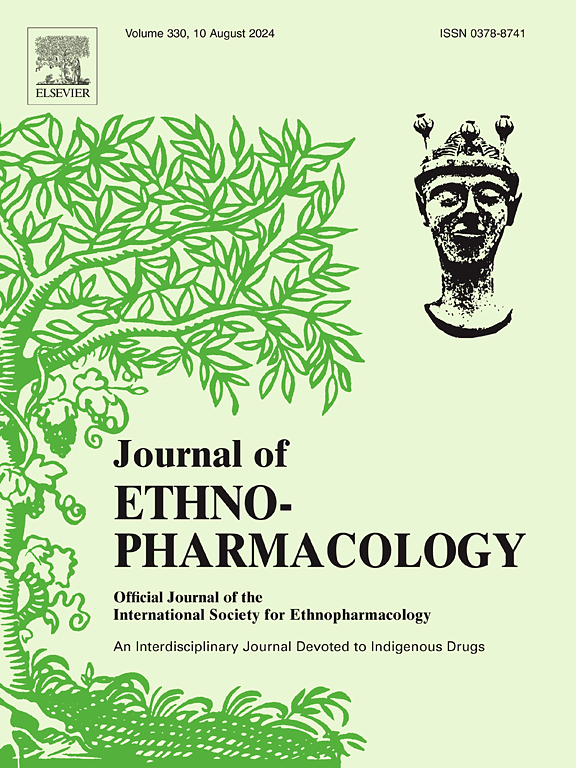LC-MS/MS profiling and toxicological evaluation of Argania spinosa extract: Acute and subacute studies in Swiss Albino mice with in vivo and in silico approaches
IF 4.8
2区 医学
Q1 CHEMISTRY, MEDICINAL
引用次数: 0
Abstract
Ethnopharmacological relevance
Argania spinosa (L.) Skeels, argan tree, scientifically known as (Arganier, أرݣان, ارڨان) and formerly referred to as Sideroxylon spinosum, is a tree endemic to southwestern Morocco. It is widely recognized for its numerous ethnobotanical and pharmacological properties, making it a valuable resource both ecologically and economically.
Aim of the study
The objective of the current study was to evaluate the acute and subacute toxicity profiles of Argania spinosa leaves extracts in mice, as well as the composition determined by LC–MS/MS, was employed to analyze and identify the compounds present in the extract. The primary compound in the studied extract, was selected for molecular docking analysis to explore its inhibitory mechanism against toxicity proteins.
Materials and methods
In the acute study, the extract was given to adult Swiss Albino mice via oral and intraperitoneal routes at doses ranging from 0 to 7 g/kg. In the subacute dose study, the extract was administered orally to adult mice at daily doses of 100, 250, and 500 mg/kg for 28 days. Body weight, along with selected biochemical and hematological parameters, was monitored. At the end of the treatment period, histological evaluations of the liver, kidney, and spleen were performed to identify any potential organ damage.
Results
Seventeen compounds were detected in the extract using LC–MS/MS analysis, with luteolin-7-O-glucoside, isorhamnetin-7-O-pentose, and quercetin-3-O-glucoside being the most prevalent. The predicted pharmacokinetic properties, indicate that the isolated compounds are well-absorbed, with a high human intestinal absorption. The acute toxicity evaluation revealed LD50 values of 6 g/kg for oral administration and 4 g/kg for intraperitoneal administration of the extract. During the subacute toxicity assessment, no notable alterations in body weight or organ weights were observed. Similarly, no changes in hematological or biochemical parameters were noted. Microscopic examination of vital organs such as the liver, kidneys, and spleen revealed no significant lesions.
Conclusion
In conclusion, the leaves of Argania spinosa, revealing an interesting phytochemical composition. Furthermore, they exhibited no toxicity, making them a potential source of beneficial compounds for various applications, such as pharmaceuticals, and food products.
液相色谱-质谱/质谱分析及棘豆提取物的毒理学评价:体内和计算机方法对瑞士白化病小鼠的急性和亚急性研究。
民族药理学相关性:阿格尼亚·spinosa (L.)Skeels,摩洛哥坚果树,科学上被称为(Arganier, أرݣان, ارڨان),以前被称为Sideroxylon spinosum,是摩洛哥西南部特有的树木。它因其众多的民族植物学和药理特性而被广泛认可,使其成为生态和经济上宝贵的资源。研究目的:本研究的目的是评价刺毛楤木叶提取物对小鼠的急性和亚急性毒性特征,并采用LC-MS/MS测定其成分,对提取物中的化合物进行分析和鉴定。选取提取物中的主要化合物进行分子对接分析,探讨其对毒性蛋白的抑制机制。材料与方法:在急性研究中,以0 ~ 7g /kg的剂量,通过口服和腹腔给药给成年瑞士白化病小鼠。在亚急性剂量研究中,以100、250和500 mg/kg的日剂量口服成年小鼠,持续28天。监测体重以及选定的生化和血液学参数。在治疗期结束时,对肝脏、肾脏和脾脏进行组织学评估,以确定任何潜在的器官损伤。结果:通过LC-MS/MS分析,共检出17种化合物,其中以木犀草素-7- o -葡萄糖苷、异鼠李素-7- o -戊糖、槲皮素-3- o -葡萄糖苷含量最多。预测的药代动力学性质表明,分离的化合物吸收良好,具有较高的人体肠道吸收。急性毒性评价显示,口服给药的LD50值为6 g/kg,腹腔给药的LD50值为4 g/kg。在亚急性毒性评估期间,未观察到体重或器官重量的显著变化。同样,血液学或生化参数也没有变化。肝、肾、脾等重要器官镜检未见明显病变。结论:综上所述,刺毛螺叶片揭示了一种有趣的植物化学成分。此外,它们没有毒性,这使它们成为各种用途的有益化合物的潜在来源,例如药品和食品。
本文章由计算机程序翻译,如有差异,请以英文原文为准。
求助全文
约1分钟内获得全文
求助全文
来源期刊

Journal of ethnopharmacology
医学-全科医学与补充医学
CiteScore
10.30
自引率
5.60%
发文量
967
审稿时长
77 days
期刊介绍:
The Journal of Ethnopharmacology is dedicated to the exchange of information and understandings about people''s use of plants, fungi, animals, microorganisms and minerals and their biological and pharmacological effects based on the principles established through international conventions. Early people confronted with illness and disease, discovered a wealth of useful therapeutic agents in the plant and animal kingdoms. The empirical knowledge of these medicinal substances and their toxic potential was passed on by oral tradition and sometimes recorded in herbals and other texts on materia medica. Many valuable drugs of today (e.g., atropine, ephedrine, tubocurarine, digoxin, reserpine) came into use through the study of indigenous remedies. Chemists continue to use plant-derived drugs (e.g., morphine, taxol, physostigmine, quinidine, emetine) as prototypes in their attempts to develop more effective and less toxic medicinals.
 求助内容:
求助内容: 应助结果提醒方式:
应助结果提醒方式:


